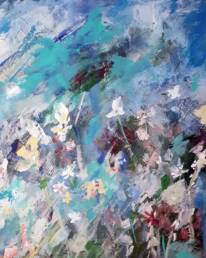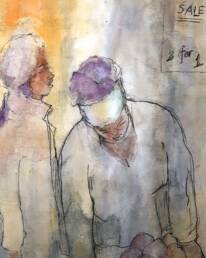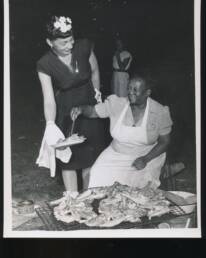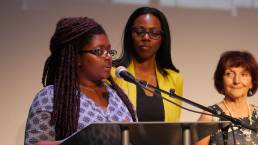Meet the Creatives: Stories Rooted in Food
May 18, 2022
By Chris Hampton
Food is a universal resource. It brings everyone to the table, literally and figuratively. For Ontario Culture Days’ 2022 Creatives in Residence program, food is the second theme our artists are responding to.
Over the past two years, the loss of gatherings, as well as food scarcity, have been important topics, both at large and among our creatives, says Ontario Culture Days Senior Adviser Meaghan Froh Metcalf. “That’s still a conversation that’s happening, particularly with the prices of everything going up in grocery stores… I think a lot of artists are holding conversations around the status of food and the value that we put on food in our communities.”
Food is a rich subject for creative exploration. It is “a touchstone for memory,” says Froh Metcalf. It marks our celebrations, and it represents our unique cultures and histories. At the same time, it’s a resource whose access is precarious for many, while its production is often overlooked and misunderstood. Food offers a way of highlighting the hidden, “under-appreciated” work that sustains our communities.
“I think food — almost more than other art forms — has lower barriers to access just because it’s something that people do all the time,” says Froh Metcalf. “I’m hoping that it provides an avenue for people to tell their own stories and that people feel comfortable sharing those details about their own family histories.”
Let’s meet the Creatives in Residence whose projects put food on the mind.


Illustrations by Angela Walcott.
Angela Walcott
Toronto-based creative Angela Walcott is a multidisciplinary visual artist, who draws, paints and creates works of collage and mixed media. She’s a freelance writer, who utilizes poetry and aspires to include elements of longform journalism in future projects, because it represents a rich canvas for storytelling.
Walcott doesn’t see these streams — visual artist and writer — as separate; rather “they’re one and the same.” What she’s doing is storytelling, she says. “For me, art is the method of exploration and understanding and connecting the dots, finding the differences and similarities that exist between things.”
Also important in her creative practice is gardening. She sees this too as a form of storytelling. However, it wasn’t until the pandemic when she began an indoor garden, that she realized how important her work with the soil was to her work with the pen or the paintbrush.
For Walcott, the garden is a place of reflection and imagination. “In the garden, you observe, and as an artist, it’s all about observation,” she says. While the hands are busy, the mind may wander. Whatever problems she was encountering with a text or a composition, she says, get worked out in the garden. “I often have to throw off the gloves and get out my sketch pad or my notebook and take down ideas.” From the soil, she harvests both vegetables and inspiration.
Lately, she’s been curious about the other home and community gardeners across Toronto. She wants to understand why people garden, what’s in their gardens, their cultural connection to gardening, and what are the cross-cultural connections between all these gardens and gardeners. “It’s a celebration for some groups, and for others, it’s a necessity. It’s a staple. It’s a way of survival. It’s a way of appreciation. And It’s a way of communication, too.”
For her residency, Walcott will lead an investigation, told visually, on the “role of gardening in people’s lives.” “What are green spaces now?” she asks. “What do they mean to us?” For her, the garden represents hope. “I think that where we’re coming from, that’s what we need right now.”


Photos of Windsor’s Emancipation Day celebrations, courtesy of the E. Andrea Moore Heritage Collection.
Tonya Sutherland
Shortly after Tonya Sutherland completed her undergraduate studies, she had a troubling realization. She’d studied history, and though she’d taken courses on Canadian history and Black history, she was then just realizing she’d learned next to nothing about Black Canadian history. In search of information, she met actor and producer Audra Gray and retired teacher Catherine MacDonald, who’d both become interested in Windsor’s Emancipation Day celebrations. The trio saw the opportunity to uncover this history together.
Four years on, Sutherland, who’s now a historian and museum professional, is still an active member of the research initiative, called the Jackson Park Project (after the public park where the historic celebrations were centred). The project’s mission, Sutherland says, is to “commemorate and memorialize Windsor’s emancipation celebrations.” Since there’s not a lot of publicly available information that’s easy to access, she’s begun the work of building a digital archive to bring that history into the open.
From the 1930s to the 1960s, Windsor’s emancipation celebrations drew hundreds of thousands of people each year from across North America. Civil rights leaders, like a 27-year-old Martin Luther King Jr., came to speak while up-and-coming stars like Aretha Franklin, the Temptations and the Supremes performed.
For her residency, Sutherland will research the food history of these festivities. There were hot dogs and cotton candy, she lists, fried chicken, spare ribs, steak hoagies, fried fish and candy apples. “There are legendary stories about the barbecue pits that were metres and metres long.” She’s even found mention of a special Jackson Park rib sauce synonymous with the occasion, that was a closely guarded family secret. Sutherland plans to hold an event at a Windsor park during the Ontario Culture Days Festival, where she’ll present research findings alongside musical performances inspired by the former celebrations and food vendors offering historical Jackson Park favourites. It won’t be a re-enactment, she says, but she wants to evoke the feeling and flavours of the event, which was once called “the greatest freedom show on earth.”
“Food can be a lens through which you illuminate many other topics,” Sutherland says, be it geography, gender, race, economics, politics, migration or history. Or, in this case, all of those at once. “You can find a connection to somebody somewhere by talking about food.”
The Creatives in Residence community programs will be open to the public during our festival in September and October 2022.

